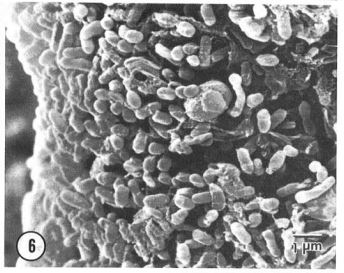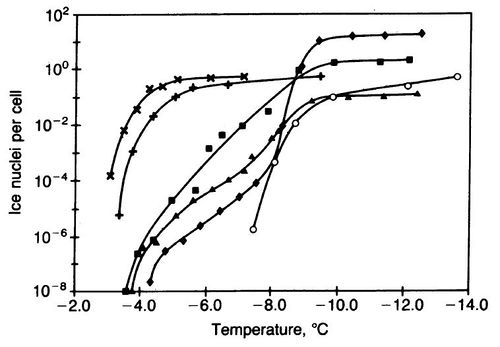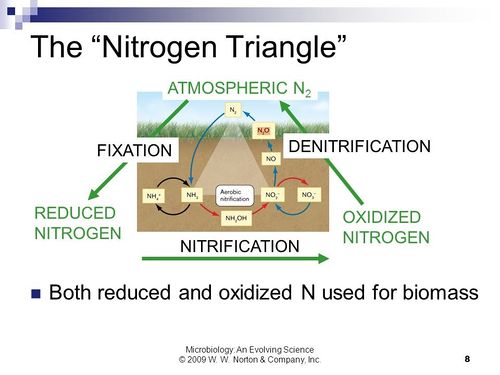Pseudomonas syringae: Bioprecipitation Mechanisms and Implications
Overview
By Brandon Byrd
Pseudomonas syringae have a significant impact on weather systems and ecosystems worldwide. This bacteria has previously been studied in depth as a plant pathogen, and it has recently been studied as a major contributor to bioprecipitation. P.syringae are rod shaped, gram-negative bacteria with polar flagella that is a plant pathogen to a wide variety of plant species at cold temperatures (Morris et al 2008). This bacteria is found in agricultural locations as well as non-agricultural locations such as clouds (Morris et al 2008). The fact that it has the capability to grow in a wide range of environments and ecosystems gives this bacteria the potential to drastically impact biogeographical systems. P.syringae also has an extraordinary ice nucleation activity which allows this bacteria to catalyze freezing water at warm temperatures which sparked interest in its role in the water cycle (Maki et al 1974). This is a major key for P.syringae’s effect on biogeographical systems. It is also important to further analyze their ice nucleation ability to understand the mechanisms in which they influence major weather systems such as the water cycle. Furthermore, how P.syringae can impact humans and biodiversity based on their influence on ecosystems and the environment.
History

.
P.syringae are a part of the pseudomonas genus (Figure 1). This genus is gram-negative aerobic proteobacteria. This genus is categorized as pathogens with a wide variety of niche potential due to much variation in metabolism across the species in this genus (Morris 2013).The history of the pseudomonas genus dates back millions of years ago to when they were found in aquatic habitats before plants and land agriculture (Morris et al. 2013). Pseudomonas is still one of the most common bacteria present in many aquatic environments today such as oceans and wetlands. Also, a study done by Pesciaroli and colleagues have shown a new strain of P.syringae to be present in intertidal aquatic environments (Morris et al. 2013). P.syringae was first discovered by Paul Hoppe in 1961 while studying corn crops for the U.S. Department of Agriculture (Parrott 1993). His study demonstrated a bacteria that caused crop freezing problems at temperatures around negative two to four degrees Celsius. His research led to further research in later years which revealed P.syringae and its ice nucleation characteristics which were causing the crop freezing problems. The crop freezing problem that occurred is that between negative eight to four degrees plant stems and roots would freeze due to the presence of P.syringae. Ice nucleation research of P.syringae has led to a cascade of promising discoveries linking this species to important bioprecipitation mechanisms that continue to influence weather in many ecosystems. There was a discovery of ice nucleation proteins that protrude from the outer membrane of P.syringae which facilitates their ice nucleation ability (Morris et al. 2013). These proteins are believed to have arisen without the use of horizontal gene transfer millions of years ago because of evidence of a three secretion system (Morris et al. 2010). The gene for the outer membrane ice nucleation protein is most likely in the core genome of proteobacteria such as pseudomonas syringae. The most likely common ancestor of this gene came from more general orders including Pseudomonadales and also Enterobacteriales (Morris et al. 2013). The study of these ice nucleation proteins have given rise to the present research regarding P.syringae in its direct significance to the water cycle and indirect significance to other biogeographical systems.
Bioprecipitation and P.syringae’s Role in Bioprecipitation

Bioprecipitation is a term used to describe the concept in which precipitation is caused by bacteria. This is important because organisms such as bacteria that can drive our precipitation patterns, due to cloud formation, of any given area can be vital in predicting weather patterns. Also it deepen our understanding of the water cycle and how the water cycle effects ecosystems based on the makeup of the microbial community. Bioprecipitation has a strong correlation with P.syringae. P.syringae is thought to have two significant roles in cloud formation that effect bioprecipitation (Morris et al. 2013). One role is that due to its warm temperature ice nucleation activity, temperatures range from subzero to eight degrees Celsius. P.syringae is an organism that can cause water vapor droplets to freeze at temperatures and conditions that normal abundant mineral ice nucleator particles are unsuccessful at achieving. The second role that this bacteria causes water vapor to freeze to a large enough size for gravity to act on the droplets in clouds which causes precipitation such as snow or rain. This is important because much of rainfall that comes from mid-high altitudes are as result of this water droplet freezing process (Morris et al. 2013). This process either occurs by nucleation minerals present in clouds or microbial life such as P.synrigae that are also present in clouds. As described by in recent studies, P.syringae bioprecipitiation is constructed within the water cycle (Christner 2012). It was first discovered by a man named David Sands in the 1970s. Sands found the same pseudomonas bacteria that caused frost damage was also found in the rainfall of that area (Prasanth 2015). The bioprecipitation process can be compartmentalized and explained in a few steps within the water cycle (Figure 2). The first step is for ice nucleators such as P.syringae to become airborne in atmosphere ready to act on water vapor and ice nuclei at very low temperatures. The second step is for ice nucleation to occur using proteins that P.syringae possesses to facilitate this process. At this step cloud formation occurs and condensation of water vapor and ice nuclei takes place. The third step is traditional for the water cycle: the cloud becomes too heavy and gravity pulls the snow, rain, or any other form of precipitation from the cloud down to the Earth’s surface. This cycle continues which could potentially have a major impact on cloud formation and climate patterns. However, it has been found that P.syringae only accounts for only a small fraction of the total microbial life deposited by rainfall (Christner 2012). This makes it difficult to make the claim that bioprecipitation caused by P.syringae influences ecosystems on a global scale. However, research has suggested that P.syringae and other similar bacteria lose their ability to be cultured but continue their high ice nucleation activity (Christner 2012). This leaves more opportunity to explore how the rate of ice nucleation via P.syringae effects bioprecipitation despite their low atmospheric population discovered through precipitation samples. Also, the potential potency of P.syringae increases because they are able to grow in a wide range of environments (Morris et al. 2014). This bacteria’s life cycle can be conducted in air-borne environments, as well as soil and non-air-borne environments. Other microbial species’ life cycle are heavily dependent on air-borne distribution and deposition through rainfall. These species have recently been shown to be high in ice nucleation activity as well (Morris et al. 2014). This is noteworthy because more microbes other than P.syringae may have a high impact on bioprecipitation. This could also potentially explain the low population numbers of P.syringae in precipitation samples. A deeper understanding of P.syringae’s protein structure and function regarding ice nucleation is important to expanding knowledge on bioprecipitation as a whole.
Mechanisms for Ice Nucleation

Include some current research, with at least one figure showing data.
P.syringae ice nucleation is due to the proteins within its outer membrane of the bacteria. This protein is known as the lnaZ protein. The structure of InaZ has been studied in depth as well. Model simulations have proposed the structure of ice nucleation proteins such as InaZ to have on side for the purpose of organizing water molecules into an ice structure, and the other side of the protein for binding to the cell membrane of the bacteria (Kajava and Lindow 1993). More recent studies have shown that there are significant greater amounts of beta-sheets than alpha-helices in quaternary protein structure (Graether and Jia 2001). The significance of this is not known, but these results produce an intriguing area of research since increasing our knowledgebase of the InaZ protein structure influencing its function will aid in understanding the mechanisms of InaZ proteins. Studies have proven that the lnaZ protein is coded by the p153 gene in P.syringae (Wolber et al. 1986). P.syringae with functioning InaZ proteins have a genotype of InaZ+ whereas P.syringae without functioning InaZ have a genotype of InaZ-. Most InaZ- P.syringae are mutates in comparative studies regarding InaZ protein function in an experiment (Figure 3). The main function of the InaZ protein is to participate in ice crystallization of pure water. Other studies have shown that there is no evidence that the ice nucleation protein serves any function other than ice nucleation; therefore, the positive natural selection of the InaZ protein is based on the ability of an organism to ice nucleate (Morris et al. 2014). There are two types of crystallization: homogeneous and heterogeneous. Homogeneous crystallization occurs when the right conditions-negative eight to four degree temperature range, water vapor, atmospheric pressure- are reached for the formation of ice due to a group of water molecules to orientate their particles into a certain order (Wolber et al. 1986). This type of crystallization is also known as ice nuclei crystallization. Heterogeneous crystallization is when solid, non-water molecules, are used for ice formation sites (Wolber et al. 1986). P.syringae InaZ proteins conduct homogenous or ice nuclei crystallization. The efficiency of the ice crystallization depends on the environmental conditions and cell concentration. Wolber and colleagues also found a common repeating Alanine-Glycine-Tyrosine-Glycine-Serine-Threonine-Leucine pattern within a 1200 amino acid sequence in the InaZ protein complex. This sequence is considered to be responsible for water molecule organization due to alterations in spatial location and alignment prompting ice formation (Cid et al. 2016). The most favorable environment for optimal P.syringae is a high water vapor environment, although there has been a water vapor threshold or capacity where efficiency becomes independent of the concentration (Wolber et al. 1986). However, InaZ have been shown to be more efficient than other ice nucleators such as other fungi species and ash, dust, soot, and other ice nucleation minerals (Morris et al. 2014). One proposed reason for this is that P.syringae InaZ proteins have more amounts of ice active sites per surface area of their cells in fungi InaZ proteins. The mechanisms of InaZ gene to protein pathways and InaZ protein function are still being investigated in the present day.
Ecological Implications of
P.syringae Bioprecipitation

Include some current research, with at least one figure showing data.
Conclusion
References
Authored for BIOL 238 Microbiology, taught by Joan Slonczewski, 2016, Kenyon College.
